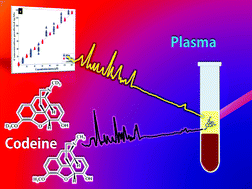Quantitative detection of codeine in human plasma using surface-enhanced Raman scattering via adaptation of the isotopic labelling principle†
Abstract
In this study surface enhanced Raman scattering (SERS) combined with the isotopic labelling (IL) principle has been used for the quantification of codeine spiked into both water and human plasma. Multivariate statistical approaches were employed for the analysis of these SERS spectral data, particularly partial least squares regression (PLSR) which was used to generate models using the full SERS spectral data for quantification of codeine with, and without, an internal isotopic labelled standard. The PLSR models provided accurate codeine quantification in water and human plasma with high prediction accuracy (Q2). In addition, the employment of codeine-d6 as the internal standard further improved the accuracy of the model, by increasing the Q2 from 0.89 to 0.94 and decreasing the low root-mean-square error of predictions (RMSEP) from 11.36 to 8.44. Using the peak area at 1281 cm−1 assigned to C–N stretching, C–H wagging and ring breathing, the limit of detection was calculated in both water and human plasma to be 0.7 μM (209.55 ng mL−1) and 1.39 μM (416.12 ng mL−1), respectively. Due to a lack of definitive codeine vibrational assignments, density functional theory (DFT) calculations have also been used to assign the spectral bands with their corresponding vibrational modes, which were in excellent agreement with our experimental Raman and SERS findings. Thus, we have successfully demonstrated the application of SERS with isotope labelling for the absolute quantification of codeine in human plasma for the first time with a high degree of accuracy and reproducibility. The use of the IL principle which employs an isotopolog (that is to say, a molecule which is only different by the substitution of atoms by isotopes) improves quantification and reproducibility because the competition of the codeine and codeine-d6 for the metal surface used for SERS is equal and this will offset any difference in the number of particles under analysis or any fluctuations in laser fluence. It is our belief that this may open up new exciting opportunities for testing SERS in real-world samples and applications which would be an area of potential future studies.

- This article is part of the themed collection: RSC papers by GRC Bioanalytical Sensors 2018 Speakers


 Please wait while we load your content...
Please wait while we load your content...